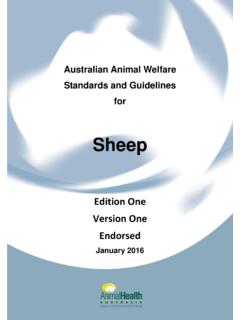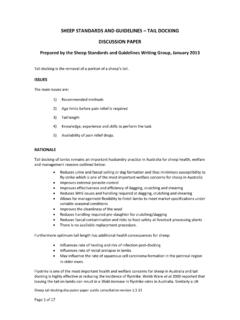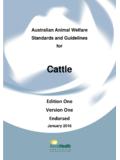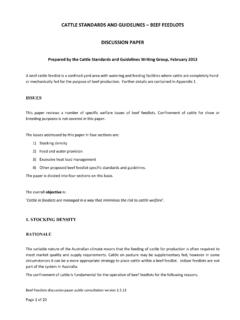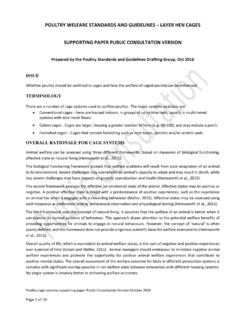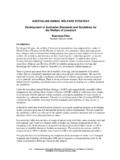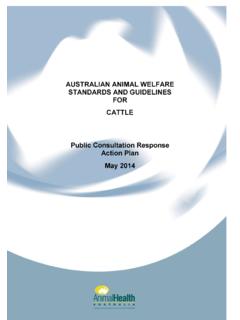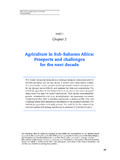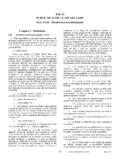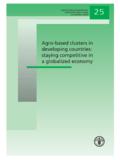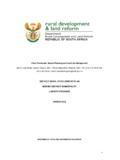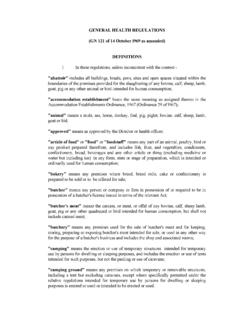Transcription of LAND TRANSPORT OF LIVESTOCK - Animal Welfare …
1 I land TRANSPORT OF LIVESTOCK AUSTRALIAN Animal Welfare STANDARDS AND GUIDELINES Edition One Version 21 September 2012 This document describes the Welfare standards and guidelines for the land TRANSPORT of LIVESTOCK and has been prepared under the auspices of the Australian Animal Welfare Strategy Standing Council on Primary Industries ii This document forms part of the Australian Standards and Guidelines for the Welfare of Animals. This publication is a stand-alone document. Suggestions and recommendations for amendments should be forwarded to: Animal Health Australia Manager, Veterinary Services Suite 15, 26 28 Napier Close Deakin ACT 2600 Tel: 02 6232 5522; Fax: 02 6232 5511 email: Approved citation: Australian Animal Welfare Standards and Guidelines land TRANSPORT of LIVESTOCK . Animal Health Australia (AHA) 2012, Canberra. Publication record: Edition 1 Version 1, 2008 Version: , 21 September 2012 Available on the internet at Commonwealth of Australia and each of its states and territories, 2012 ISBN 978-1-921958-03-8 (electronic version) This work is copyright and, apart from any use as permitted under the Copyright Act 1968, no part may be reproduced without written permission from the publishers, the Australian Government Department of Agriculture, Fisheries and Forestry (DAFF) and Animal Health Australia, acting on behalf of the Standing Council on Primary Industries (SCoPI).
2 Requests and inquiries concerning reproduction and rights should be addressed to Animal Health Australia (see above). The publishers give no warranty that the information contained in the manual is correct or complete, and shall not be liable for any loss, howsoever caused, whether due to negligence or other circumstances, arising from use of or reliance on this code. Production assistance by Biotext Pty Ltd, Canberra iii C o n t e n ts Abbreviations and acronyms .. v Preface ..vii Introduction .. 1 Principles relating to the TRANSPORT of LIVESTOCK .. 3 Part A General standards and guidelines for the TRANSPORT of LIVESTOCK .. 5 1 Responsibilities and planning .. 7 Objectives .. 7 Standards .. 7 Guidelines .. 8 2 Stock-handling competency .. 15 15 Standard .. 15 Guidelines .. 15 3 TRANSPORT vehicles and facilities for LIVESTOCK .. 17 17 Standard .. 17 Guidelines .. 17 4 Pre- TRANSPORT selection of LIVESTOCK .. 19 19 Standards.
3 19 Guidelines .. 19 5 Loading, transporting and unloading LIVESTOCK .. 23 23 Standards .. 23 Guidelines .. 25 6 Humane destruction .. 33 33 Standards .. 33 Guidelines .. 33 Part B Species standards and guidelines for the TRANSPORT of LIVESTOCK .. 39 B1 Specific requirements for the land TRANSPORT of alpacas .. 41 Standards .. 41 Guidelines .. 42 B2 Specific requirements for the land TRANSPORT of buffalo .. 47 iv Australian Animal Welfare Standards and Guidelines land TRANSPORT of LIVESTOCK Edition 1, Version Standards .. 47 Guidelines .. 47 B3 Specific requirements for the land TRANSPORT of camels .. 53 Standards .. 53 Guidelines .. 54 B4 Specific requirements for the land TRANSPORT of 59 Standards .. 59 Guidelines .. 60 B5 Specific requirements for the land TRANSPORT of deer .. 65 Standards .. 65 Guidelines .. 66 B6 Specific requirements for the land TRANSPORT of emus and ostriches .. 71 Standards .. 71 Guidelines .. 72 B7 Specific requirements for the land TRANSPORT of goats.
4 79 Standards .. 79 Guidelines .. 79 B8 Specific requirements for the land TRANSPORT of horses .. 83 Standards .. 83 Guidelines .. 84 B9 Specific requirements for the land TRANSPORT of 89 Standards .. 89 Guidelines .. 89 B10 Specific requirements for the land TRANSPORT of poultry .. 95 Standards .. 95 Guidelines .. 96 B11 Specific requirements for the land TRANSPORT of sheep .. 101 Standards .. 101 Guidelines .. 101 Glossary .. 105 v A b b r ev i a t i o n s a n d a c r o n ym s AAC Animal Advisory Committee ABAH Australian Bureau of Animal Health AWWG Animal Welfare Working Group CSIRO Commonwealth Scientific and Industrial Research Organisation PISC Primary Industries Standing Committee SCARM SCoPI Standing Committee on Agriculture and Resource Management Standing Council on Primary Industries vii Pr e f a c e The Australian Animal Welfare Standards and Guidelines land TRANSPORT of LIVESTOCK are an important component of the Australian Animal Welfare Strategy (AAWS) an Australian Government initiative that guides the development of new, nationally consistent policies to enhance Animal Welfare arrangements in all Australian states and territories.
5 The standards provide a basis for developing and implementing consistent legislation and enforcement across Australia, and provide guidance for all people responsible for LIVESTOCK during TRANSPORT . They are based on current scientific knowledge, recommended industry practice and community expectations. The development of these standards is the inaugural project in a comprehensive program under the AAWS to develop standards and guidelines for all commercial LIVESTOCK species and at all points along the production supply chain. They were developed in consultation with state and territory governments, LIVESTOCK industry organisations, Animal Welfare groups and the general public under the auspices of the Animal Welfare Committee, which is ultimately responsible to the Standing Council on Primary Industries. The standards were drafted by a small writing group comprising researchers and government and industry representatives, supported by a widely representative reference group and managed by Animal Health Australia.
6 An important part of the process was the preparation of a Regulation Impact Statement to assess the proposed standards and evaluate costs resulting from changes to existing requirements. An extensive consultation process was undertaken, with the final public consultation highlighting ethical and practical issues and leading to the development of more robust standards. The reference group carefully considered the views and comments of all stakeholders in developing the final standards and guidelines for recommendation to the Standing Council on Primary Industries. While these standards reflect a high level of agreement about the Welfare aspects of land TRANSPORT , it is recognised that there are some contentious issues where it has not been possible to reach complete agreement at this time. In particular, the current standards for TRANSPORT of calves, time off water and loading density do not represent complete agreement. The reference group has resolved that bobby calf TRANSPORT issues will be reviewed within two years, with relevant government and industry parties firmly committed to improving calf Welfare outcomes within that time frame.
7 In the interim, it is recognised that some jurisdictions may adopt additional regulatory requirements for the TRANSPORT of calves. These standards and guidelines replace the following model codes of practice: Draft Model Code of Practice for the Welfare of Animals land TRANSPORT of Sheep Model Code of Practice for the Welfare of Animals land TRANSPORT of Cattle, PISC/SCARM Report 77 CSIRO Publishing, 2000 Model Code of Practice for the Welfare of Animals land TRANSPORT of Horses, PISC/SCARM Report 62 CSIRO Publishing, 1997 Model Code of Practice for the Welfare of Animals land TRANSPORT of Pigs, PISC/SCARM Report 63 CSIRO Publishing, 2003 viii Australian Animal Welfare Standards and Guidelines land TRANSPORT of LIVESTOCK Edition 1, Version Model Code of Practice for the Welfare of Animals land TRANSPORT of Poultry, PISC/SCARM Report 91 CSIRO Publishing, 2006 Model Code of Practice for the Welfare of Animals Rail TRANSPORT of LIVESTOCK , AAC and ABAH, 1983 Model Code of Practice for the Welfare of Animals Road TRANSPORT of LIVESTOCK , AAC and ABAH, 1983.
8 The standards and guidelines also replace provisions on LIVESTOCK TRANSPORT in the following codes of practice: Model Codes of Practice for the Welfare of Animals: Animals at Saleyards, PISC/SCARM Report Series 31, CSIRO Publishing, 1991 Model Codes of Practice for the Welfare of Animals: Cattle, PISC/SCARM Report Series 85, CSIRO Publishing, 2004 Model Codes of Practice for the Welfare of Animals: Domestic Poultry, PISC/SCARM Report Series 83, CSIRO Publishing, 2002 Model Codes of Practice for the Welfare of Animals: Farmed Buffalo, PISC/SCARM Report Series 52, CSIRO Publishing, 1995 Model Codes of Practice for the Welfare of Animals: Farmed Ostriches, PISC/SCARM Report Series 84, CSIRO Publishing, 2003 Model Codes of Practice for the Welfare of Animals: Feral LIVESTOCK Animals, PISC/SCARM Report Series 34, CSIRO Publishing, 1992 Model Codes of Practice for the Welfare of Animals: Husbandry of Captive-Bred Emus, PISC/SCARM Report Series 90, CSIRO Publishing, 2006 Model Codes of Practice for the Welfare of Animals: LIVESTOCK at Slaughtering Establishments, PISC/SCARM Report Series 79, CSIRO Publishing, 2001 Model Codes of Practice for the Welfare of Animals: Pigs, PISC/SCARM Report Series 66, revised draft in press, 2007 Model Codes of Practice for the Welfare of Animals: The Camel, PISC/SCARM Report Series 86, CSIRO Publishing, 2006 Model Codes of Practice for the Welfare of Animals: The Farming of Deer, PISC/SCARM Report Series 30, CSIRO Publishing, 1991 Model Codes of Practice for the Welfare of Animals: The Goat, PISC/SCARM Report Series 32, CSIRO Publishing, 1991 Model Codes of Practice for the Welfare of Animals: The Sheep, PISC/SCARM Report Series 29, CSIRO Publishing, 1991 The Primary Industry Ministerial Council endorsed the Edition 1, Version 1 in 2008.
9 This council is now the Standing Council on Primary Industries and is served by the Primary Industries Standing Committee (PISC). PISC endorsed the revisions that were incorporated in Edition 1, Version at their meeting on 21 September 2012. The preparation of these standards represents a significant investment by all parties, especially members of the writing and reference groups. Their efforts are acknowledged by Animal Health Australia. 1 I n t r o d u c t i o n Purpose The purpose of this document is to describe standards and guidelines that ensure the Welfare of LIVESTOCK during land TRANSPORT . The standards provide the basis for developing and implementing consistent legislation and enforcement across Australia, and guidance for all those responsible for LIVESTOCK during land TRANSPORT . They reflect available scientific knowledge, current practice and community expectations. The standards and guidelines may be reflected in the industry-based quality-assurance programs that include LIVESTOCK Welfare provisions.
10 Scope These standards and guidelines cover the TRANSPORT of LIVESTOCK by road and rail, and by LIVESTOCK TRANSPORT vehicle aboard a ship. They apply to the major commercial LIVESTOCK industries in Australia: alpacas, buffalo, camels, cattle, deer, emu, goats, horses, ostrich, pigs, poultry (meat chickens, layers, turkeys, ducks, geese, pheasants, guinea fowl, partridge, quail and pigeons) and sheep. The standards apply to all those responsible for the care and management of LIVESTOCK that are transported, including drivers, TRANSPORT companies, owners, agents and LIVESTOCK handlers at farming enterprises, depots, saleyards, feedlots and LIVESTOCK -processing plants. The chain of responsibility for LIVESTOCK Welfare in TRANSPORT begins with the owner or their agent, and extends to the final receiver of the LIVESTOCK . These standards and guidelines should be considered in conjunction with other requirements for transporting LIVESTOCK , and related Commonwealth, state and territory legislation, including: for TRANSPORT the Australian Standards for the Export of Livestock1, LIVESTOCK health and biosecurity requirements, and regulated LIVESTOCK loading schemes and driver regulations for other enterprises model codes of practice or standards and guidelines for LIVESTOCK species, saleyards, LIVESTOCK processing (slaughter) establishments and the Australian Standards for the Export of LIVESTOCK .
